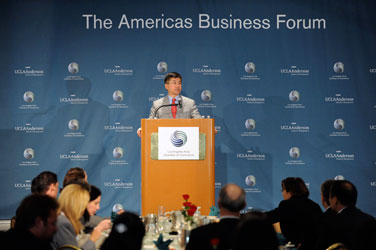|
|
|
|||||||||
|
Expanding Trading Partnerships in the Western Hemisphere A two-day event in Los Angeles allowed southern California companies to learn about new export opportunities and ways to use Department of Commerce resources to penetrate new markets in the Western Hemisphere. by Monica McFarlane Canada and countries in the Caribbean and Latin America are some of the best trading partners for the United States. They are very familiar with U.S. brands and highly receptive to U.S. products. On May 27–28, 2009, more than 200 businesspeople heard about how they can capitalize on those advantages during the Americas Business Forum, which was held in downtown Los Angeles, California, and centered on creating jobs through exports.
The forum was a collaborative effort involving the U.S. and Foreign Commercial Service, the Los Angeles Area Chamber of Commerce, the City of Los Angeles, and the Anderson School of Management at the University of California–Los Angeles. Secretary of Commerce Gary Locke, who gave the event’s keynote speech, emphasized the economic importance of trade. He told attendees that one of his highest priorities “is to help the United States expand and develop strong and fair trading partnerships in this hemisphere and around the globe. Trade can create jobs and economic growth for American workers and companies.” Senior Commercial Officers Bring In-Depth Knowledge The first day featured presentations by government and private-sector experts, who shared their insights on the legal aspects of exporting, the best ways to protect intellectual property, new opportunities created by free trade agreements, the successful management of logistics and channels of distribution, the effective identification of new business opportunities, and ways to adapt to local business practices. Later, during breakout sessions, forum participants explored the Canadian, Caribbean, and Latin American markets in more detail, with briefings given by senior commercial officers posted in U.S. embassies throughout the region. Forum participants gained valuable insights from specialists who know those markets the best. Breakout session topics included the Andean Free Trade Market, Ecuador and Venezuela, the North American Free Trade Agreement (NAFTA) area, the Central America–Dominican Republic–United States Free Trade Agreement (CAFTA–DR), and the Common Market of the South (MERCOSUR). Focus on Small Businesses The second day was devoted to a series of 20-minute, one-on-one meetings between senior commercial officers and participating representatives from small and medium-sized enterprises. Trade specialists from the five U.S. Export Assistance Centers in southern California coordinated the meetings. More than 280 meetings were held, which allowed participating companies to receive immediate feedback on the potential of their products and services without having to spend a lot of time and money traveling to each location. In many cases, senior commercial officers researched the potential in advance, thus allowing companies to discuss specific opportunities and market-entry strategies. Agreements Facilitate Trade The United States currently has four trade agreements in those regions: two multilateral agreements—NAFTA and CAFTA–DR—and two bilateral agreements with Chile and Peru. The trade agreements have helped open new markets for U.S. products and services, expanded opportunities for U.S. workers, and made U.S. firms more competitive. In 2006, for example, U.S.–Chile trade was two and one-half times greater than in 2003, before the free trade agreement went into effect. And trade with Chile continues to grow. In 2008, U.S. exports to Chile grew 49.4 percent over 2007. U.S. exports to NAFTA and CAFTA–DR partners have also continued to rise—by 6.5 percent and 12.5 percent, respectively, from 2007 to 2008. Prosperity and New Markets Businesses in southern California are in an ideal location to explore the tremendous export potential in the Western Hemisphere. “As a gateway to the Americas, southern California businesses have a tremendous untapped opportunity in Latin America,” noted Gary Toebben, president and chief executive officer of the Los Angeles Area Chamber of Commerce. Events such as the Americas Business Forum help highlight those opportunities and are part of the Department of Commerce’s strategy to lead the way for U.S. firms seeking to do business in those regions. “We are focused,” emphasized Locke, “on creating a broader foundation of prosperity that opens new markets, expands trade, and powers new growth all across the hemisphere.” Monica McFarlane is an international trade specialist with the U.S. and Foreign Commercial Service.
|
|
